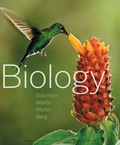
Concept explainers
During signal transduction (a) the cell converts an extracellular signal into an intracellular signal that leads to a change in some cell process (b) a signaling molecule directly activates or represses several genes (c) each enzyme catalyzes production of one molecule of product (d) enzymes in the signal cascade remain active until the last component of the pathway alters a cellular process (e) the signal is terminated by cyclic AMP
Introduction: There are four sequences of events that take place in cell signaling. These are signal transmission, reception, signal transduction, and response. In signal transduction, the cell changes the extracellular signals into intracellular signals. Cell generates a number of internal molecules that work in a specific manner.
Answer to Problem 1TYU
Correct answer: Signal transduction is a process in which extracellular signals get converted into intracellular signals. Hence the correct answer is option (a).
Explanation of Solution
Reason for the correct answer:
Option (a) is given as “the cell converts an extracellular signal into an intracellular signal that leads to a change in some cell process”. In signal transduction, the cell changes the received extracellular signals into intracellular signals. Cell generates a number of internal molecules that work in a specific manner to cause a response. It may either activates genes or deactivate it.
Hence the correct answer is option (a).
Reasons for incorrect answers:
Option (b) is given as, “a signaling molecule directly activates or represses several genes”. A signaling molecule activates several downstream molecules which either activate or deactivates the genes. This is not part of signal transduction event. Hence, option (b) is incorrect.
Option (c) is given as, “each enzyme catalyzes production of one molecule of product”. The signal get amplified at each downstream of the pathway in which an enzyme catalyzes several other molecules. This is not part of signal transduction event. Hence, option (c) is incorrect.
Option (d) is given as, “enzymes in the signal cascade remain active until the last component of the pathway alters a cellular process”. Enzyme in the signal cascade gets inactivated once it activates the downstream molecules. It does not remain active until the last component for the pathway alters the process. This is not part of signal transduction event. Hence, option (d) is incorrect.
Option (e) is given as, “the signal is terminated by cyclic AMP”. Cyclic AMP is an effector molecule. It does not terminate the signal. The signal is terminated by phosphodiesterase which inactivates the cyclic AMP to AMP or phosphatase which inactivates the protein by removing phosphate group. This is not part of signal transduction event.
Hence, option (e) is incorrect.
Hence the options (b), (c), (d), and (e) are incorrect.
Signal transduction is a process in which extracellular signals get converted into intracellular signals which causes changes in cell processes.
Want to see more full solutions like this?
Chapter 6 Solutions
EBK BIOLOGY
- How is a protein destined for the Endoplasmic Reticulum (ER), imported into the ER? Be concise.arrow_forwardFind out about the organisations and the movements aimed at the conservation of our natural resources. Eg Chipko movement and Greenpeace. Make a project report on such an organisation.arrow_forwardWhat are biofertilizers and mention the significancearrow_forward
- PCBs and River Otters: Otters in Washington State’s Green-Duwamish River have high levels of polychlorinated biphenyls (PCBs) in their livers. PCBs can bind to the estrogen receptors in animals and disrupt the endocrine system of these otters. The PCBs seem to increase the estrogen to androgen ratio, skewing the ratio toward too much estrogen. How would increased estrogen affect the river otter population? Based on your reading of the materials in this unit, what factors can affect fertility in humans? Explain how each of the factors affecting human fertility that you described can disrupt the human endocrine system to affect reproduction.arrow_forwardOther than oil and alcohol, are there other liquids you could compare to water (that are liquid at room temperature)? How is water unique compared to these other liquids? What follow-up experiment would you like to do, and how would you relate it to your life?arrow_forwardSelection of Traits What adaptations do scavengers have for locating and feeding on prey? What adaptations do predators have for capturing and consuming prey?arrow_forward
- Competition Between Species What natural processes limit populations from growing too large? What are some resources organisms can compete over in their natural habitat?arrow_forwardSpecies Interactions Explain how predators, prey and scavengers interact. Explain whether predators and scavengers are necessary or beneficial for an ecosystem.arrow_forwardmagine that you are conducting research on fruit type and seed dispersal. You submitted a paper to a peer-reviewed journal that addresses the factors that impact fruit type and seed dispersal mechanisms in plants of Central America. The editor of the journal communicates that your paper may be published if you make ‘minor revisions’ to the document. Describe two characteristics that you would expect in seeds that are dispersed by the wind. Contrast this with what you would expect for seeds that are gathered, buried or eaten by animals, and explain why they are different. (Editor’s note: Providing this information in your discussion will help readers to consider the significance of the research).arrow_forward
 Biology (MindTap Course List)BiologyISBN:9781337392938Author:Eldra Solomon, Charles Martin, Diana W. Martin, Linda R. BergPublisher:Cengage Learning
Biology (MindTap Course List)BiologyISBN:9781337392938Author:Eldra Solomon, Charles Martin, Diana W. Martin, Linda R. BergPublisher:Cengage Learning Human Physiology: From Cells to Systems (MindTap ...BiologyISBN:9781285866932Author:Lauralee SherwoodPublisher:Cengage Learning
Human Physiology: From Cells to Systems (MindTap ...BiologyISBN:9781285866932Author:Lauralee SherwoodPublisher:Cengage Learning Human Biology (MindTap Course List)BiologyISBN:9781305112100Author:Cecie Starr, Beverly McMillanPublisher:Cengage Learning
Human Biology (MindTap Course List)BiologyISBN:9781305112100Author:Cecie Starr, Beverly McMillanPublisher:Cengage Learning Biology: The Dynamic Science (MindTap Course List)BiologyISBN:9781305389892Author:Peter J. Russell, Paul E. Hertz, Beverly McMillanPublisher:Cengage Learning
Biology: The Dynamic Science (MindTap Course List)BiologyISBN:9781305389892Author:Peter J. Russell, Paul E. Hertz, Beverly McMillanPublisher:Cengage Learning Biology 2eBiologyISBN:9781947172517Author:Matthew Douglas, Jung Choi, Mary Ann ClarkPublisher:OpenStax
Biology 2eBiologyISBN:9781947172517Author:Matthew Douglas, Jung Choi, Mary Ann ClarkPublisher:OpenStax BiochemistryBiochemistryISBN:9781305577206Author:Reginald H. Garrett, Charles M. GrishamPublisher:Cengage Learning
BiochemistryBiochemistryISBN:9781305577206Author:Reginald H. Garrett, Charles M. GrishamPublisher:Cengage Learning





